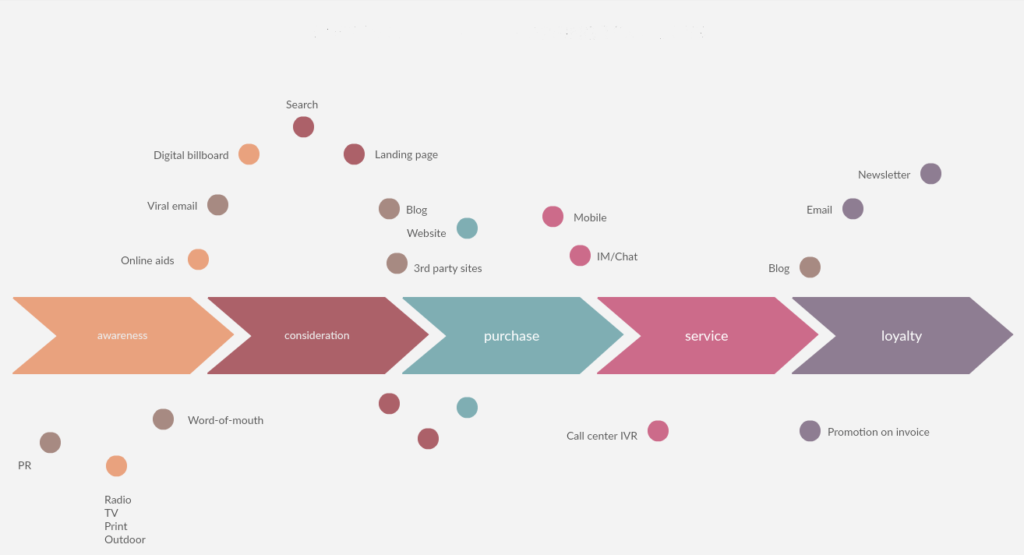The customer experience is critical to every company’s long-term viability. It is critical to have an optimized and tailored client journey for this to be positive.
This customer journey’s enhancement is a work in progress. However, focusing on this development when it pulls you away from your primary business might be difficult. Outsourcing is the greatest option, allowing companies to focus their approach on their customers. However, understanding all the aspects of the customer journey in order to make it fluid, engaging, and rich is critical. In our article, we will explore the inner working of the customer journey, the mapping aspect of it, and also how it works in the omnichannel environment.
Defining a typical customer journey for a business
The client journey may appear easy and uncomplicated at first look. Today, however, there are a plethora of alternative actions and channels. We now have to deal with a consumer that uses many channels. As a result, we must consider that there are as many pathways as there are consumers, each of whom will select the channel of their choosing at each stage.
It’s critical to design a typical customer journey based on the identified personas in order to react to all of these changes. A mapping approach can be used to do this.
The customer journey is defined as the path traveled and activities done by a prospect or client from the moment he or she recognizes a need until the purchase act. As a result, it considers the complete customer experience throughout the process (emotions, negative or positive feelings).
It is based on an examination of the prospect’s/behavior customer’s throughout the various stages of the purchase act, as well as the periods of reflection and research that precedes it, the discovery of the product/service, the phases of use and evaluation, and the possibility of recommending the product/service to others.
The “touchpoints” with the firm or brand, which define the customer journey, determine how customers connect with a brand or company through various channels.
These contact points, which can be physical or digital, include a consumer’s arrival on a website in search of information, conversation with a customer care representative, as well as an online or in-store purchase.
These touchpoints are prioritized for analysis since they are a useful source of data for assessing the client journey and it works as follows:

The Key role of Contact Centers
The increased focus on digital channels and new communication technology allows for new methods to engage with clients. Techniques are emerging to better satisfy customer expectations before, during, and after the purchase/use, whether it’s before, during, or after the purchase/use.
The contact center is an important part of the client journey because of this. It will handle a variety of customer care duties across many channels and at various phases of the purchasing process.
Companies gain from using a contact center along the client journey in three ways.
- Customer satisfaction should be improved: Indeed, teleconsultants have been taught to react to requests successfully. In the event of discontent, they employ active listening and empathy, making it simple to identify solutions that suit the caller.
- Enhancing customer loyalty: By using the proper procedures and technologies, the call center will enable you to deliver a level of service that is unrivaled by the competitors. You’ll put your consumers in touch with genuine customer service experts.
- Collecting information & data: Indeed, a Contact center’s purpose is to assess customer happiness and gather feedback in order to discover consumer expectations and potential corporate dysfunctions.
Using a contact center to map out your client journey will also help you to determine which channel is the best to employ based on where he is in his journey. This technique tries to optimize your resources and channels so that you can provide the correct information at the right time and in the most effective manner.
Client journey in the Omnichannel environment
Consumers, who are accustomed to rapid exchanges and information gathering via digital channels, also expect to connect with businesses instantly, at any time, and in any location. Because of the pervasiveness of information demand, professionals must adapt to today’s new difficulties.
Fluidity is now the key to the consumer experience. As a result, businesses must consider the omnichannel consumer and create a strategy that is tailored to their needs.
What makes the Omnichannel so unique?
 Customers’ expectations have changed as a result of new technology. As a result, the customer-brand connection has become more complicated. Not only is it no longer sufficient to provide a decent product at a reasonable price, but physical storefronts are no longer the sole point of sale to advertise.
Customers’ expectations have changed as a result of new technology. As a result, the customer-brand connection has become more complicated. Not only is it no longer sufficient to provide a decent product at a reasonable price, but physical storefronts are no longer the sole point of sale to advertise.
The number of contact and buying channels has increased dramatically. Today, a firm must know its target like the back of its hand in order to not only provide a great product or service but also outperform its competition. To make your consumers’ experience more fluid, you must invest in the digital field while combining conventional channels. Only a few businesses have ever succeeded in this endeavor.
The answer to this challenge is the omnichannel customer journey. Its goal is to unify the client experience so that you may deliver a high-quality offer independent of the channel. We have, without a doubt, reached the era of the experience. All of your contacts with consumers are now a component of your value offering.
It’s a strategic error to fail to offer an experience that is personalized to the channels your target consumer likes. In 2020, 86 percent of customer support personnel will be more discriminating and have significantly greater expectations than in 2019. As customers become more attentive and on the lookout, this tendency continues to develop year after year. So, if your rivals are likely to provide an omnichannel customer experience that meets or exceeds your consumers’ expectations, you can expect them to be delighted.
Implementing an omnichannel customer journey strategy
Following a few essential steps will help you create a successful omnichannel customer journey. Here’s how you can create a better client experience in that particular environment:
Improve your understanding of customers
To begin, it is self-evident that in order to place the customer at the heart of your plan, you must first get to know them by offering them a voice. Customer satisfaction surveys are a great method to get useful and relevant information about your customers. Indeed, the opinions expressed by your customers will be turned into vital insights, allowing you to segment your customers and better understand their requirements and expectations.
This method of gathering client feedback is all the more significant since it will help you gain a deeper knowledge of your target market and allow you to customize customer care interactions as well as marketing and sales messaging. You’ll also profit from a more successful approach because you’ll optimize the channels that your consumer groups favor.
Customer data should be centralized
 To provide a premium service, you must retain the data in one location once it has been acquired. Connected technologies can help you centralize your consumer data:
To provide a premium service, you must retain the data in one location once it has been acquired. Connected technologies can help you centralize your consumer data:
A customer relationship management (CRM) system gives you a central database to manage your customers. As a result, you have access to a centralized history of interactions with your clients.
Feedback gathering may be automated using an e-reputation solution in conjunction with your CRM tool. As a result, satisfaction surveys may be delivered at crucial points in the customer experience to help you learn more about your customers.
To provide a consistent quality experience, each staff must be able to locate a customer’s information in a matter of seconds, regardless of time or location. Hence, the need of a cloud contact center solution that can blend perfectly with your CRM.
Maintain a secure connection at all times
In practice, conventional methods, as well as new digital technologies, must be used to establish privileged relationships with your target. Customers, for example, are increasingly favoring so-called conversational solutions to stay in touch with companies.
Conversational bots and Webchats have shown to be an effective self-care aid in dealing with the flood of requests generated by this new type of digital connection. In fact, since 2016, several businesses have adopted the practice in order to show their consumers that they are always available. You may guarantee that your consumers are comforted by designing clever scenarios geared at resolving frequent, low-value queries. Your consumers no longer have to wait on the phone for extended periods of time or worse, have an easy way to reach you.
Once established, you’ll be able to customize the client experience and therefore improve the service you’re offering. It’s important to remember that the experience must be consistent across all interaction channels. You will maintain a powerful and believable message while also reinforcing your business image in this manner.
Make the client experience more personalized
Finally, any omnichannel customer-centric approach must provide a tailored customer experience. To do so, your firm must have completed its digital transition effectively. Then, across all consumer touchpoints, you’ll need to provide customized actions. For example, a loyalty program that may be utilized in-store as well as online. Or special event notifications (customer birthdays, private sales for loyal customers, etc.) automatically delivered through the channel most likely to be utilized by your target at the moment.
Conclusion: The key to your success is feedback
 The contact center industry is no longer dormant, as it used to be and an omnichannel approach is implemented and refined throughout the life of your business, as we’ve just seen. In reality, in order to be relevant, it must continually adapt to new consumer habits, new expectations of your target audience, and new technologies that are always emerging.
The contact center industry is no longer dormant, as it used to be and an omnichannel approach is implemented and refined throughout the life of your business, as we’ve just seen. In reality, in order to be relevant, it must continually adapt to new consumer habits, new expectations of your target audience, and new technologies that are always emerging.
As a result, your entire staff must keep up with the latest trends and tools on the market. And, if competitive intelligence allows you to discover novelties ahead of other actors, customer feedback will show to be a highly valuable source of information since it is more grounded in your target’s reality.
Customer satisfaction surveys play a critical function in gathering input from customers. They not only provide your consumers a voice and identify their pain spots along the customer journey, but they also give you a head start on innovation when compared to rivals who wait for yearly market studies to be released. You may prioritize and implement effective and adaptable activities and technologies once you’ve recognized the irritation points as essential components of your offer.
This customer-centric strategy ensures a significant competitive edge against an ever-increasing number of fierce competitors. However, that’s only part of the puzzle, the next step is mapping your customer journey. Find out more in our part 2 article.

Michael McGuire is a contact center industry expert with almost two decades of experience in the space. His experience includes roles as Director of Contact Center Digital Transformation at NobelBiz, and as Director of Operations at FLS Connect, managing multiple call centers. As President of Anomaly Squared and Targeted Metrics, Michael successfully transitioned companies into remote operations and significantly boosted revenues. With a strong background in customer service, leadership, strategic planning, and operations management, Michael excels in driving growth and innovation in the call center space.
Mike is also a proud Board Member for R.E.A.C.H Trade Group, promoting consumer protection and satisfaction and Co-host of the Off Skripted Podcast – a show about Life, Call Centers and everything in between.







